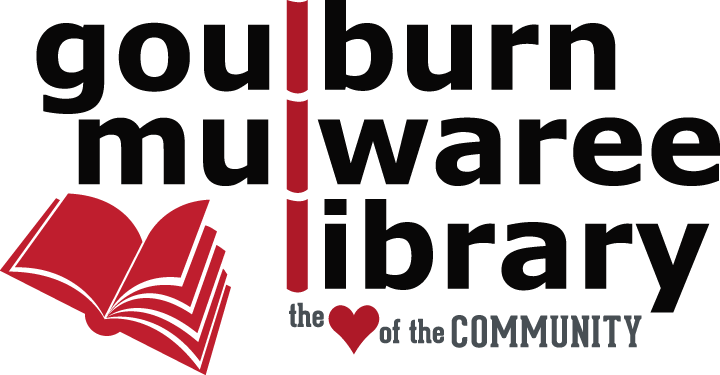Kenmore Psychiatric Hospital
An Extraordinary Place in Goulburn's History
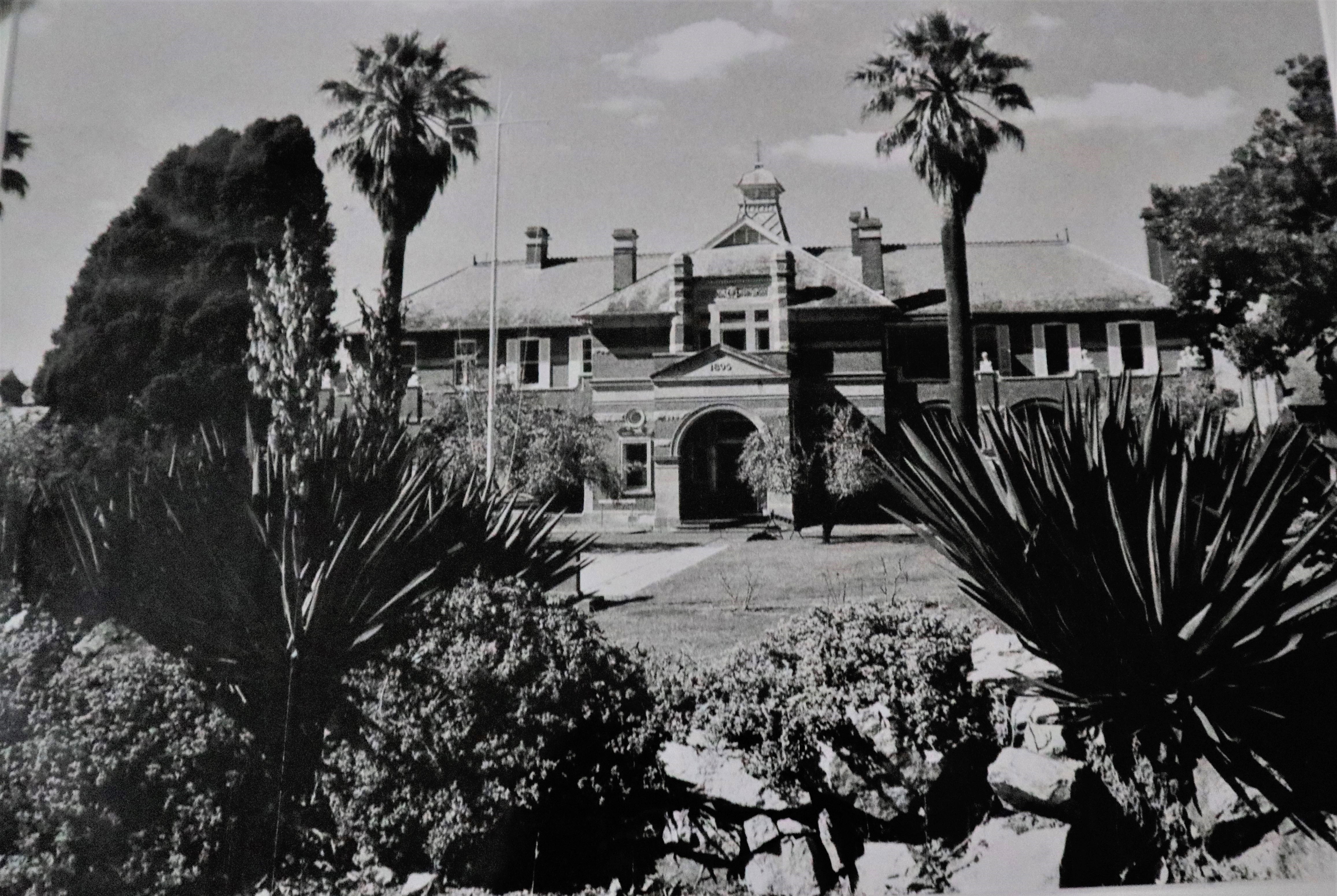
Administration building at Kenmore Hospital. Photograph: Joe Medway, 1993.
In 2011 Goulburn Mulwaree Library was the grateful recipient of a large number of photo albums from the Kenmore Hospital Museum. The collection of over 600 photographs captures interiors, equipment, staff, patients, and random snapshots of a place, people and time unique to Goulburn. Approximately 400 of these photos have been digitised and are available online in the Library's Archives Collection.
Included in the collection is a set of over 50, A3 sized descriptive black and white photos of the grounds and buildings, taken by Joe Medway. Joe, a previous employee at Kenmore Hospital and a keen photographer, was a passionate advocate for recognising and preserving Kenmore Hospital’s history. Joe’s photos are a beautiful and moody record of just a small portion of the buildings and grounds that made up Kenmore Hospital.

Left: Dr. Chisholm Ross - first medical superintendant of Kenmore Hospital. It was rumoured that Dr. Ross kept a Himalayan honey bear in the grounds of the hospital, and this would fit with the belief at that time that nature and animals had a significant part to play in the rehabilitation of the mentally ill. Ref No. 2013988, photograper unknown, 1895. Right: Stained glass window at Kenmore Hospital. Ref No. 2014115, Photograph: Ben Sayers, 2006.
Buildings and Grounds
The construction of Kenmore Hospital commenced in 1894 and the core group of buildings were completed by the early 1900s.
Frederick Norton Manning, Inspector General of the Insane for the Colony of NSW, was part of the wave of change that had moved away from the idea of confinement and punishment of the mentally ill left over from colonial times.
How and where the patients were housed, the restorative effect of a beautiful landscape, and meaningful use of their time (the beautiful rockeries throughout the grounds of Kenmore Hospital are a testament to this theory and to the hard work of staff and patients). All these things and more were taken into consideration when designing Kenmore Hospital.
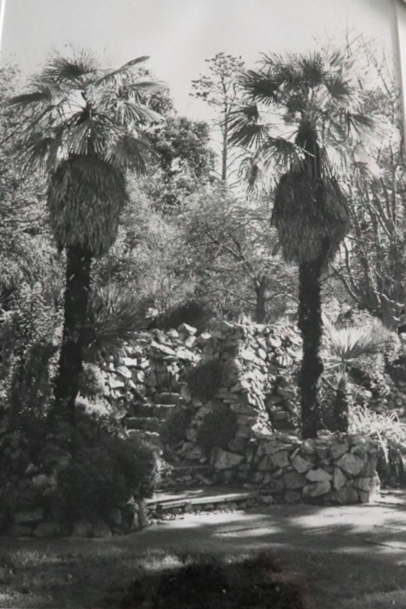
Rock garden at Kenmore Hospital. For generations the beautiful gardens, created by staff and patients, were a popular backdrop for wedding photos. Photograph: Joe Medway, 1993.
Manning and the appointed Government architect, Col. Walter Liberty Vernon, consulted closely and the outcome was considered by many to be an outstanding example of the pavilion system of asylum layout and Edwardian and Federation Free Style architecture in Australia.

Senior staff residence taken from the clock tower. Photograph: Joe Medway, 1998.
According to the Kenmore Hospital Conservation Management Plan Review (1999), the clock tower was not originally commissioned for Kenmore Hospital. Rather, it turned up unannounced and was duly installed by 1899 (it was never determined who the clock was meant for – surely a headache for someone, somewhere, at stock take time!).
Interestingly, the chimes were based on the tones of London's Big Ben and the bell that was attached to the outside of the tower at a later date was to prove invaluable as a fire alarm. Twice a week, an agile staff member had to ascend the tower’s interior ladder to wind the mechanism.
Today, the clock is not operational, but it was repaired in 1989 and the mechanism was reported as being in good working order at that time.
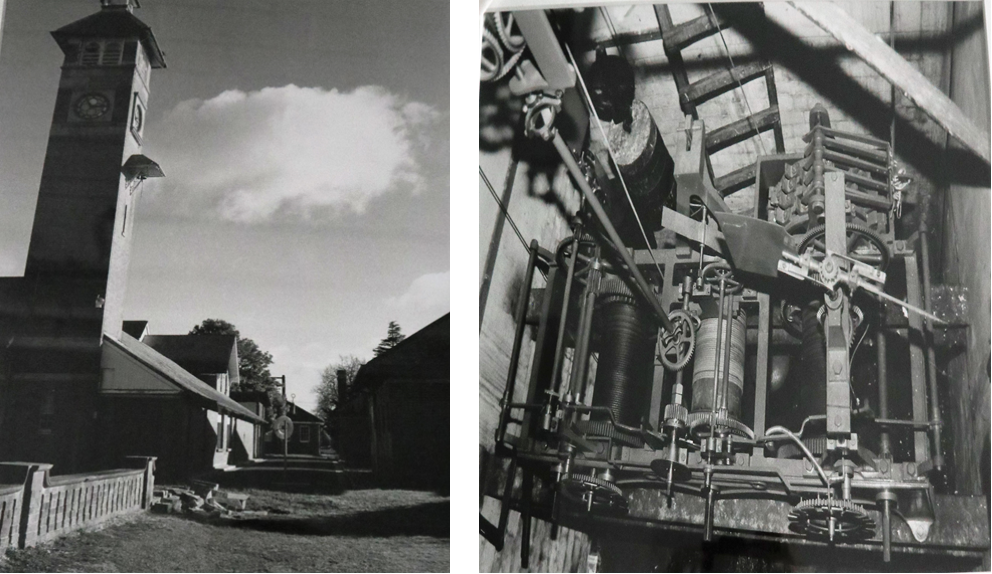
Left: The exterior bell was added at a later date and was used as a fire alarm. Photograph: Joe Medway, 1998. Right: The interior ladder of the clock can be glimpsed in the top of the picture. Twice weekly a staff member climbed up the tower to wind the mechanism. Photograph: Joe Medway, 1998.
Kenmore Hospital had been designed to be self-sufficient and in its prime could be described as a small village. There was provision made for a farm (meat was swapped with bread from the gaol), orchard, piggery, dairy, apiary, a commercial sized kitchen, laundry (later destroyed by fire), boot maker, seamstresses, and its own mortuary and various other workshops.
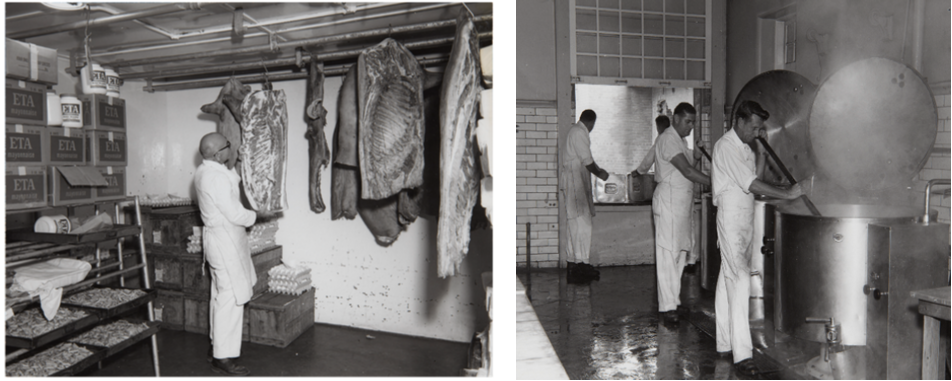
Left: Butchers storeroom. Ref. No. 2013833, photographer and date unknown. Right: Cooking boilers Kenmore Hospital kitchen. In its busiest years, it was not uncommon for the kitchen to prepare over 3,000 meals in one day. Ref. No. 2013822, photographer and date unknown.
The old store was housed beneath the clock tower and was in use for over 100 years until its closure in 1992. Beneath this was a cellar where meat was stored. It regularly reached temperatures below zero during winter and was also subject to flooding.
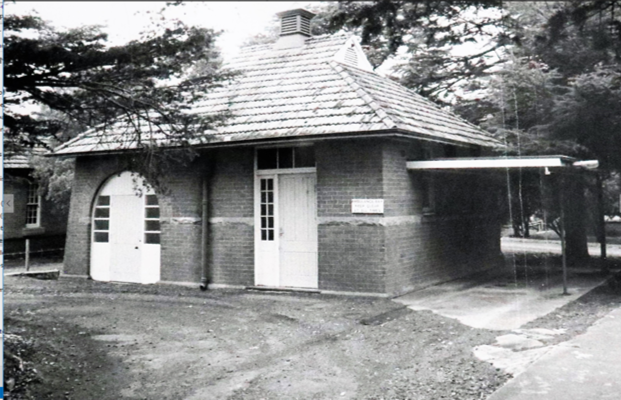
Kenmore Hospital had its own mortuary. Built in 1895, it ceased function with the introduction in 1980 of the NSW Coroners Act. Photograph: Joe Medway, 1998.
Working at Kenmore Hospital

Left: Fannie, Lizzie, and Jack Naughton. Ref. No. 2014052, photographer unknown, circa 1913. Right: Bev Barden, Maureen Williams, Leone Morgan, and Lorraine Hyde, retired nurses from Kenmore Hospital. Photograph: Goulburn Mulwaree Library, 2021.
On the 7th April 2021, Goulburn Mulwaree Library’s Oral History Team interviewed four Goulburn locals who had experience of working at Kenmore Hospital from the 1960s onwards. Memories of Kenmore provides a fascinating insight into the methods, hardships, and joys of caring for psychiatric patients over a number of decades. It’s clear from the stories told by these ex-staffers that there was an enormous rapport and understanding developed between nurses and patients. Despite the long hours and the sometimes confronting nature of the work, there was consensus amongst the interviewees that the camaraderie and sense of fun was overriding compensation for the harsher realities of working at Kenmore Hospital - there was no shortage of entertaining characters and behind every patient was a fascinating and often tragic story.
It can’t be forgotten however, that there was an element of danger in this environment, and this is illustrated by the tragic story of nurse Elizabeth Naughton who was shot and killed by a disgruntled and shell shocked ex-patient, Richard Sindell on the 16th December 1922.
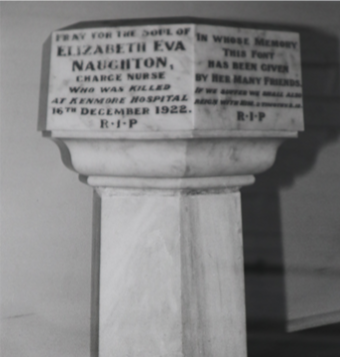
Elizabeth Naughton memorial font. Photograph: Joe Medway, 1993.
A bizarre footnote to this incident was the disappearance of the marble memorial font (weighing 165 kilos) dedicated to her memory. Two years later, an anonymous tip off to police directed them to its unexplained re-appearance in a Canberra alleyway.

Left: The 1919 version of personal protective equipment for nurses during the Spanish Influenza Pandemic. Ref. No. 2014013, photographer unknown, circa 1919. Right: Draughthorse ready for work. Ref. No. 2014006, photographer and date unknown.
Disturbed patients weren’t the only hazards for staff working at Kenmore Hospital in the early part of the 20th Century. The Spanish Influenza Pandemic of 1918-1919 was responsible for at least 21 patient deaths, 19 of them male (it’s thought that because some were housed in open verandah wards in winter that this contributed to the mortality rate).
Fires were also a real danger and the horse drawn lawn mowers were in constant use during the hot summer months to keep the grass in check. Despite these efforts, a number of buildings have been lost to fires over the years (the occasional patient was also known to contribute to the fire hazard!).

No. 7 male open air ward (later destroyed by fire. Ref. No. 2013779, photograph: William James Dewhurst, 1920.
The Army Comes to Town - 114 Australian General Hospital

A convoy of double decker buses transported most of the patients to other psychiatric centres while the very ill were transported by train. Ref. No. 2014109, photographer unknown, 1942.
In 1942, much to the dismay of many in the Goulburn community, the Army was offered Kenmore Hospital as a repatriation centre and hospital for returned soldiers, displacing most of the existing patients and staff.
The Army emptied the hospital of over 1,000 patients and train loads of equipment. A report to the Governor General of Mental Hospitals at the time described the evacuation as '...likened to the wholesale removal of a country town'. A significant source of employment was removed from the community and many no longer had ready access to family and loved ones being treated at Kenmore Hospital.
Despite this rocky start, recovering soldiers were soon invited into Goulburn homes to enjoy some home cooking and a welcome reminder of family life (it’s unlikely this hospitality was extended to the small number of POWs, mainly Japanese and Italian, that were housed in one of the wards).

Soldiers with a cow at Kenmore Hospital. Ref. No. 2013913, photographer unknown, 1942.
The Army, however, was not wholly prepared for the scope and size of Kenmore Hospital, and its first attempts at managing the farm were hindered by staff completely unqualified for the task. A second unit, more experienced in farm management, was eventually arranged to replace the first, and order was restored.
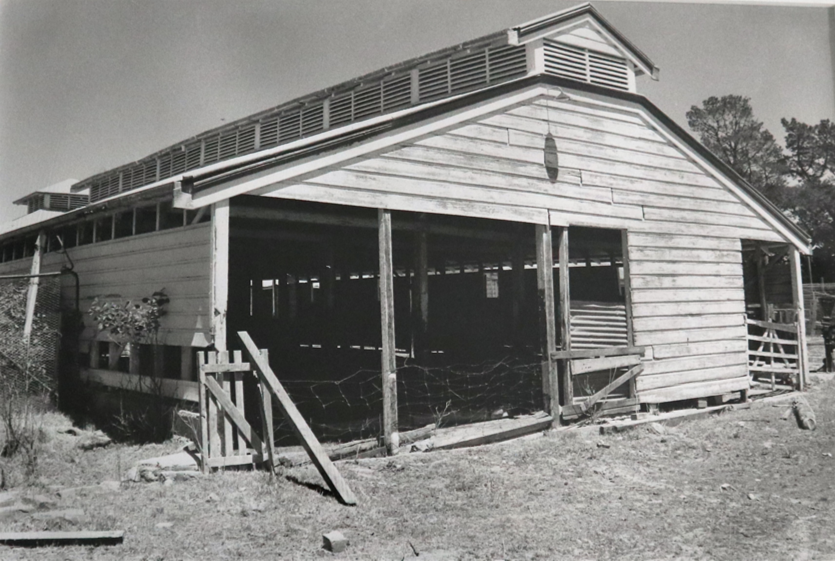
Dairy shed at Kenmore Hospital. Photograph: Joe Medway, 1998.
By early 1946, the hospital was passed back under the responsibility of the State and the patients gradually returned as the Army took its leave.
It’s generally acknowledged that the Army left Kenmore Hospital in a better state than they found it, and a memorial to soldiers from both World Wars stands in the grounds.
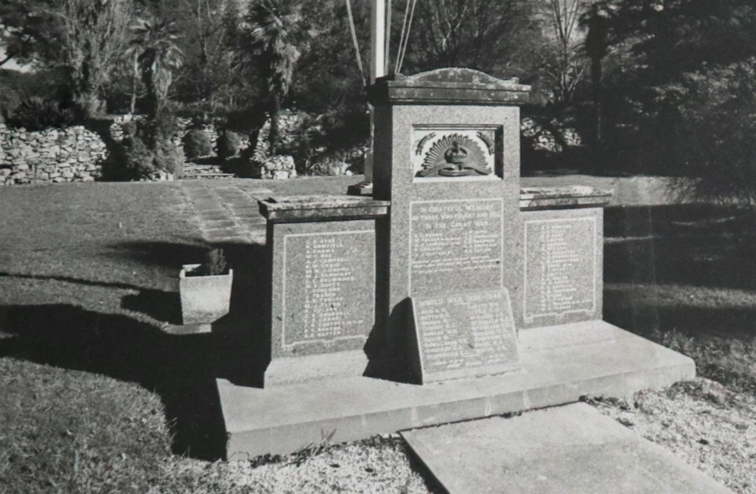
A memorial to returned soldiers from both World Wars can be found in the grounds of Kenmore Hospital. Photograph: Joe Medway, 1998.
A Village within a Town
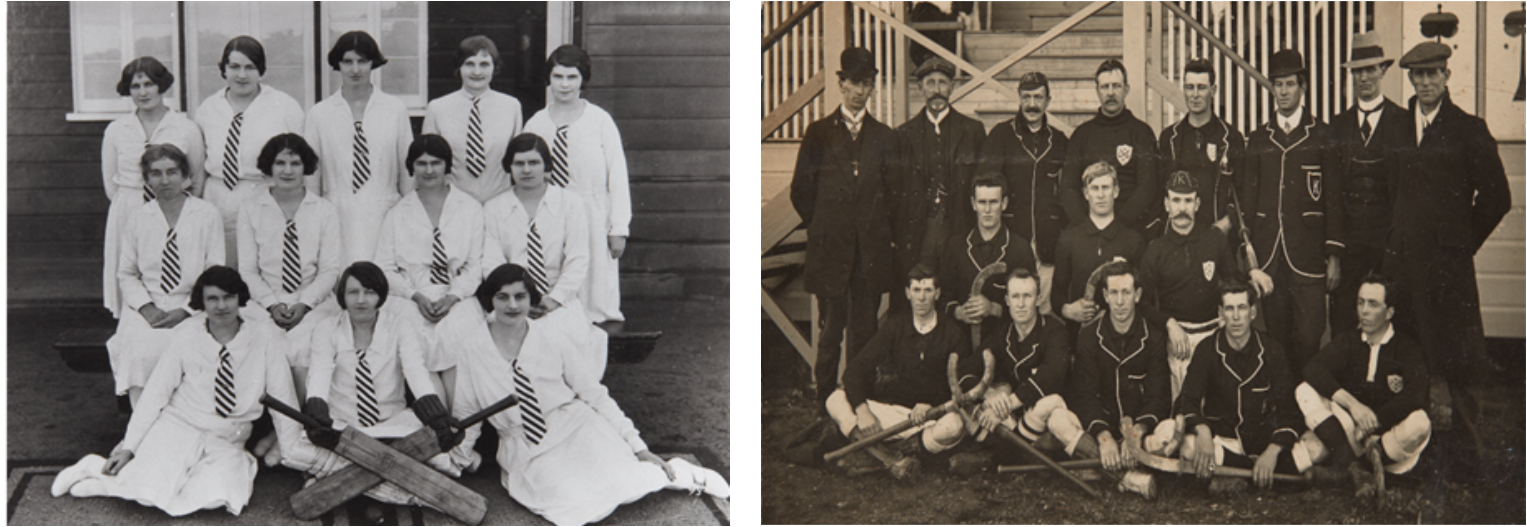
Left: Kenmore Hospital women's cricket team. Ref. No. 2013671, photographer unknown, circa 1920s. Right: Kenmore Hospital hockey club. Ref. No. 2013673, photographer unknown, 1913.
In its prime, Kenmore Hospital was inextricably tied to Goulburn’s community – particularly in the sporting arena. A local who played cricket for decades at Kenmore Hospital described ‘the standard of the pitch as equal to any in Australia’, and according to The History of Goulburn, (Ransome T. Wyatt, 1941), the community seriously embraced hockey when it was introduced as a recreational activity for Kenmore Hospital staff around 1909. Successive generations of Goulburn school children have had their first taste of this sport on the Kenmore Hospital playing fields - a handful even reaching Olympic standard.
There are many photographs of the staff enthusiastically putting on plays, musicals, and entertainment for the benefit of patients. The recreation hall (which included a chapel) was used as a cinema when it acquired talking-movies equipment in the 1920s. The hall hosted many balls, celebrations, and Christmas parties for staff, their families, and patients, and for many decades the gardens of Kenmore Hospital were the favoured backdrop for the wedding photos of Goulburn newlyweds.
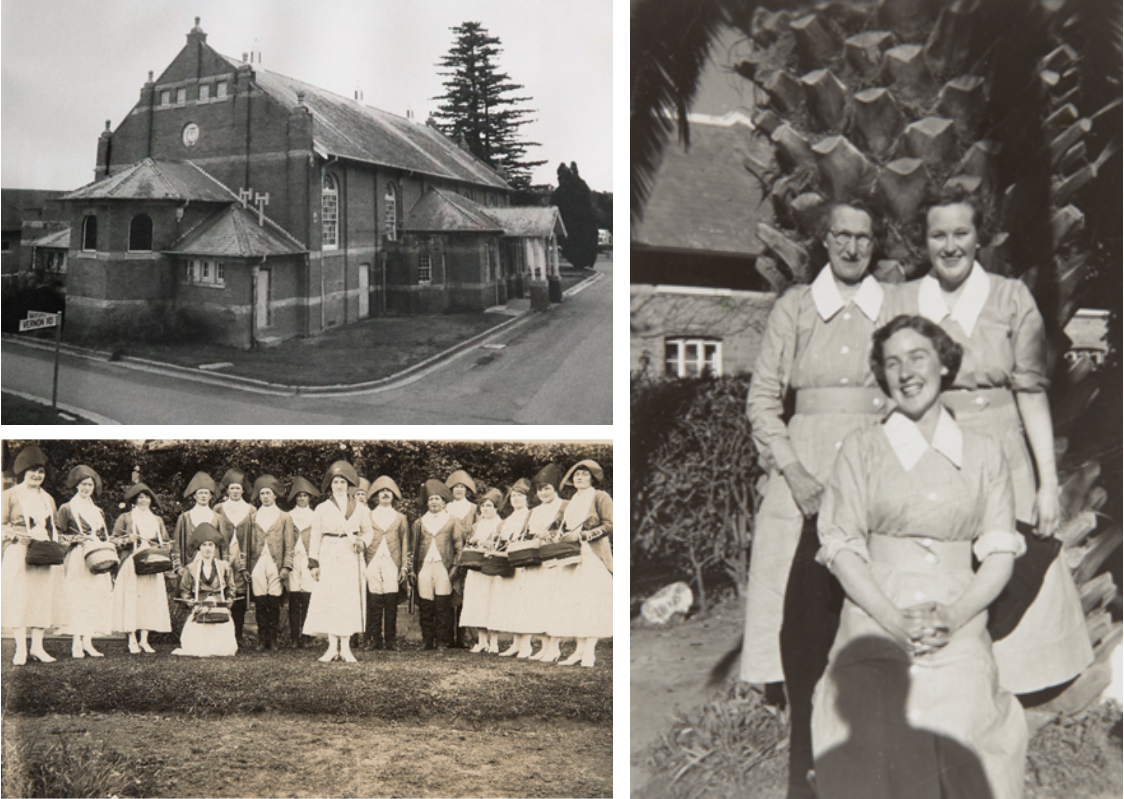
Top Left: Recreation hall and chapel. Photograph: Joe Medway, 1993. Right: Seamstresses at Kenmore Hospital. Ref. No. 2014000, photographer unknown, 1950. Bottom Left: Kenmore Hospital staff in Napoleonic Masquerade costumes. Ref. No. 2013859, photographer unknown, 1920.
Conclusion
In Brendan O’Keefe’s History of Kenmore Psychiatric Hospital, (1993) he, in part, describes Kenmore Hospital as an archaeological site showing 100 years of changing psychiatric practice.
What this description does not capture is the contribution Kenmore Hospital made to the Goulburn community. It launched hundreds of nursing and artisan careers, provided school-day memories of a place to play sport, forged many a lasting friendship, and provided a spectrum of on-the-job training for thousands of Goulburn citizens over many decades. In the first half of the 20th century Kenmore Hospital was a cultural and sporting hub for the community. Memories of working at Kenmore Hospital are frequently inter-generational and are not confined to those individuals who worked there.
Kenmore Hospital remains important and fascinating part of Goulburn's shared history.
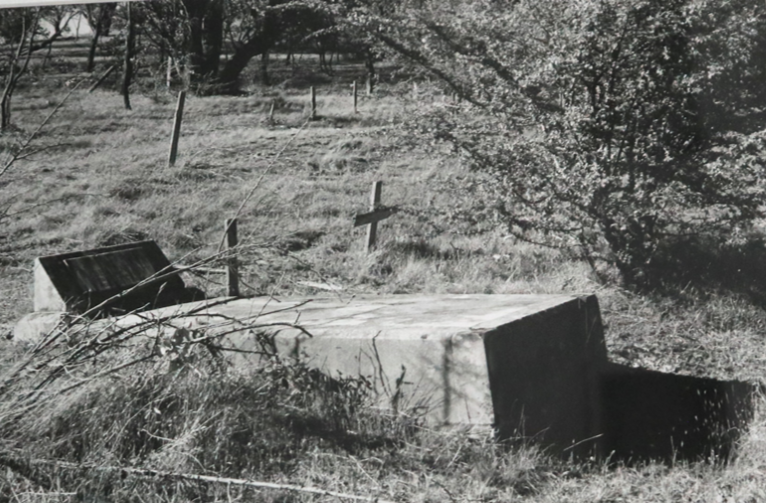
Some of the oldest paupers graves in NSW in Kenmore Hospital cemetery, which was active from 1895-1942. The graves are now unmarked, but would have once had wooden crosses on them, indicating the patients' names.
There is no public access to the Kenmore Hospital grounds and cemetery, however Goulburn Mulwaree Library has a large collection of published histories of the Hospital and archival collections including photographs, oral history interviews, and more. The photos above are part of the Library's archival collections. To find materials related to Kenmore Hospital, search the Library catalogue and Archives Collection. For more information, contact the Library.
Do you have any memories of Kenmore Hospital to share? Would you like to donate your Kenmore Hospital photos or memorabilia to the Library? If so, please contact the Library.
